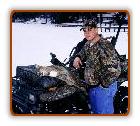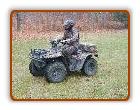Bob Cat Hunting
| Bob Cat Hunting.
For the first time in thirty years Pennsylvania allows a regulated Bob Cat hunt. |
 March 17, 2001 |
 Felis rufus or the commonly known Bobcat is a medium-sized cat with a height of up to two feet and weighing as much as 20 pounds. Their fur is spotted when they are babies, but the spots fade to light black streaks as they grow to maturity. The wild cat is usually light brown to reddish brown and has very short tails, only three to seven inches long. If someone’s hair has been cut short, people say it has been “bobbed”. Since this type of wild cat has a short tail, it is called a bobcat. The carnivorous cat has razor sharp teeth commonly found with predators. Like house cats, they keep their sharp claws inside their toes. So, when they leave a footprint, the claws do not show. Dog toenails do show up in footprints, so that is a good way to tell them apart. Bobcats are curious, like cats, but they are very shy and never come up to people. Except for the eastern central states, the bobcat lives in most of the US. It prefers woody areas or grassy areas and has a territory that may include five to fifty miles. The bobcat is generally nocturnal, partly because the animals it hunts and eats (prey) are most active at night. Bobcats like to eat rabbits, rats, squirrels, ground-nesting birds, turkeys, and even small or sick deer. Sometimes they will kill and eat chickens or lambs on a farm. Bobcats can only eat about 3 pounds of meat at a time, so if they get a big animal like a deer, they will drag it to a safe spot and cover it up. Later they will come back, eating again and again, until the meat rots. Bobcats hardly ever eat rotten meat. They have excellent vision and hearing, and use these senses most in hunting.
Felis rufus or the commonly known Bobcat is a medium-sized cat with a height of up to two feet and weighing as much as 20 pounds. Their fur is spotted when they are babies, but the spots fade to light black streaks as they grow to maturity. The wild cat is usually light brown to reddish brown and has very short tails, only three to seven inches long. If someone’s hair has been cut short, people say it has been “bobbed”. Since this type of wild cat has a short tail, it is called a bobcat. The carnivorous cat has razor sharp teeth commonly found with predators. Like house cats, they keep their sharp claws inside their toes. So, when they leave a footprint, the claws do not show. Dog toenails do show up in footprints, so that is a good way to tell them apart. Bobcats are curious, like cats, but they are very shy and never come up to people. Except for the eastern central states, the bobcat lives in most of the US. It prefers woody areas or grassy areas and has a territory that may include five to fifty miles. The bobcat is generally nocturnal, partly because the animals it hunts and eats (prey) are most active at night. Bobcats like to eat rabbits, rats, squirrels, ground-nesting birds, turkeys, and even small or sick deer. Sometimes they will kill and eat chickens or lambs on a farm. Bobcats can only eat about 3 pounds of meat at a time, so if they get a big animal like a deer, they will drag it to a safe spot and cover it up. Later they will come back, eating again and again, until the meat rots. Bobcats hardly ever eat rotten meat. They have excellent vision and hearing, and use these senses most in hunting. state has recovered to a point where it can again sustain a limited and highly regulated season. Although, some people may oppose this hunting and trapping opportunity, the Game Commission truly views the opening of these conservative seasons as a wildlife success story. Based on extensive research, the current adult bobcat population is near 3,500. A conservative objective of 175 bobcats should be harvested in NorthCentral and NorthEastern Pennsylvania – which are the only areas available for hunting or trapping of bobcats under the plan that was adopted. This particular hunt requires an application to be submitted to the Pennsylvania Game Commission. The Game Commission received 3,274 applications. From these applications 290 individuals were awarded one bobcat permit each for the upcoming 2000-2001 hunting and trapping season. The drawing was held in the agency’s Harrisburg headquarters.
state has recovered to a point where it can again sustain a limited and highly regulated season. Although, some people may oppose this hunting and trapping opportunity, the Game Commission truly views the opening of these conservative seasons as a wildlife success story. Based on extensive research, the current adult bobcat population is near 3,500. A conservative objective of 175 bobcats should be harvested in NorthCentral and NorthEastern Pennsylvania – which are the only areas available for hunting or trapping of bobcats under the plan that was adopted. This particular hunt requires an application to be submitted to the Pennsylvania Game Commission. The Game Commission received 3,274 applications. From these applications 290 individuals were awarded one bobcat permit each for the upcoming 2000-2001 hunting and trapping season. The drawing was held in the agency’s Harrisburg headquarters.
Tom Fostosck Jr., an avid ATV Connection Outdoors reader, was not only lucky enough to draw a tag he also, downed one of these large felines. Tom sent us this story of his lucky days hunt using his Arctic Cat 500 ATV. Tom’s hunt began on January 6th, 2001, in the heart of Pennsylvania’s mountainous region. A hunt for the almighty “bobcat”. The adventure begins with Tom unloading his Arctic Cat 500 and strapping on the necessary gear, including a twelve gauge shot gun. “Using my knowledge of bobcats I began scouting familiar areas”, typical denning areas include rock ledges, fallen logs and root masses of fallen trees, these are just some of Bob cat’s favorite homes. Bobcats mark their territory with their urine and that strong smell will let you know you are in the right area. Tom did not just hop on his quad and happen to get lucky when he shot his Bobcat. Tom spends a lot of time scouting the woods. Because of the previous months of scouting, Tom’s hard work was paying off. A nice sized “cat” was spotted around 8:30am. Tracking the cat was not going to be easy.
 The Bobcat has a territory that may include five to fifty miles. Like a bloodhound hot on the trail, the tracks led us through some rough terrain; most of the tracking had to be done on foot. One of Tom’s hunting companions was always nearby, “the Arctic Cat 500 never let us down”, explains Tom. “If the footprints went along a ledge or progressed some steep inclines, the ATV was always nearby”. “But four to five hours later we found ourselves out-smarted by this clever feline”, which is often the case when hunting these curious animals. The daytime was coming to an end, so we regrouped and hit a few other hot spots before dark. Using the ATVs, we moved our location and within a half-hour, a fresh track was spotted. It seemed to be a fresh track no more than 12 hours old. The tracks lead us through some thick hemlocks and along some ledges. The trees had scratch marks on them which is a big indicator a “cat” was sharpening it’s claws. With my heart racing and palms sweating, I caught a glimpse of a nice sized “cat” out of the corner of my eye. Amazed and excited, all the effort that went into this hunt was about to pay off. I quickly took the shotgun off my shoulder and made a quick shot, hopped on the ATV and scurried down the ledges. The “cat” was found a short distance away; the shot was a success. After a few snapshots and a couple of handshakes, the hunt came to an end.
The Bobcat has a territory that may include five to fifty miles. Like a bloodhound hot on the trail, the tracks led us through some rough terrain; most of the tracking had to be done on foot. One of Tom’s hunting companions was always nearby, “the Arctic Cat 500 never let us down”, explains Tom. “If the footprints went along a ledge or progressed some steep inclines, the ATV was always nearby”. “But four to five hours later we found ourselves out-smarted by this clever feline”, which is often the case when hunting these curious animals. The daytime was coming to an end, so we regrouped and hit a few other hot spots before dark. Using the ATVs, we moved our location and within a half-hour, a fresh track was spotted. It seemed to be a fresh track no more than 12 hours old. The tracks lead us through some thick hemlocks and along some ledges. The trees had scratch marks on them which is a big indicator a “cat” was sharpening it’s claws. With my heart racing and palms sweating, I caught a glimpse of a nice sized “cat” out of the corner of my eye. Amazed and excited, all the effort that went into this hunt was about to pay off. I quickly took the shotgun off my shoulder and made a quick shot, hopped on the ATV and scurried down the ledges. The “cat” was found a short distance away; the shot was a success. After a few snapshots and a couple of handshakes, the hunt came to an end.Congratulations Tom on your fine hunt, we hope you and Chip have many more days afield.
